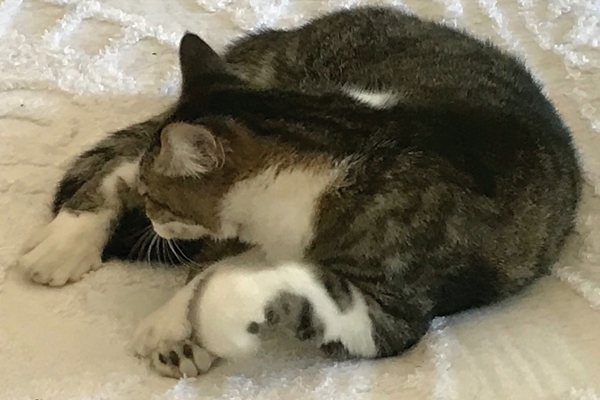
Six-toed cat in bed
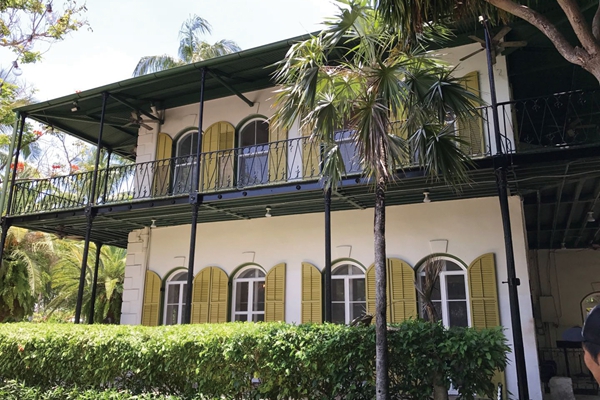
Main building of the former residence
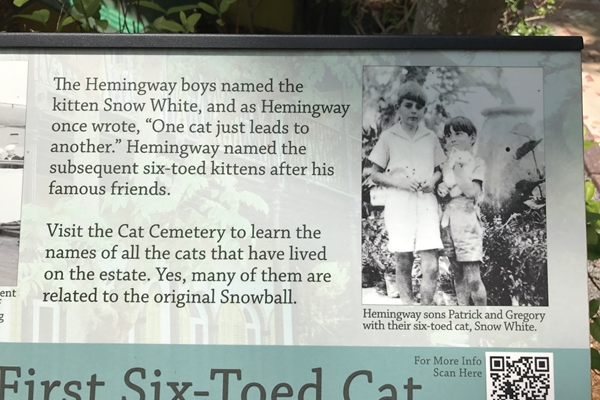
Hemingway’s two sons, Patrick and Gregory took photo with the six-toed cat Snow White.
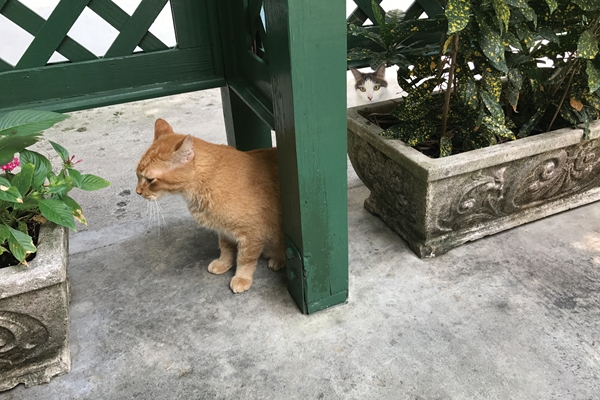
Cats in the garden
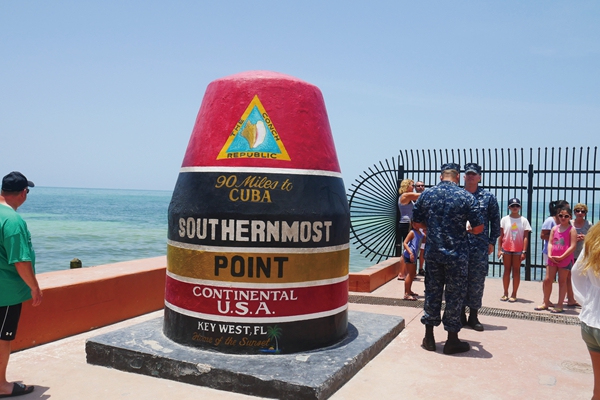
The southernmost tip of the US continent, 90 miles from Cuba
It is my wish to visit the former residence of Hemingway in Florida of the US. Fortunately, my son had been there and played the role of my guide. One day in late May, setting off from Miami, he drove us along the route 1and headed south to the Key West Island for 160 miles and passed over 40 bridges in total, one of which spanned seven miles.Each bridge artfully connected the neighboring islands, like a long string of pearls that have been scattered in the sea. The beautiful coastline and subtropical scenery stretched in the breeze as if we were driving amid the blue ocean.Standing on the long dam, the great vastness of sky and ocean and pretty view were full of our eyes.
Located at the Whitehead Street and nestled in the Key West Island, the former residence of Hemingway is by the shore of the Atlantic Ocean.A conical landmark, which is easily found from the view of the street, is the southernmost point of the United States, just 90 miles from Cuba.Painted in white and yellowgreen, the residence is of typical Spanish style surrounded by lush green trees. The garden in it is filled by flowers and the grass is as green as a blanket, featuringsmall bridges, ponds, cannas, plantain, fern leaf bamboo and other broad-leaved plants integrated with coconut and palm trees.The mainstay of the residence is a two-story white building with wooden floors, living room, bedroom, studio and kitchen. The rooms are bright and spacious with arched windows and floor-to-ceiling windows. All the displaying furniture is the originals used by the Hemingway's family. In the second-floor exhibition hall, there were two old photos of Hemingway and his wife, Martha Gellhorn, who had visited China during the War of Resistance Against Japanin 1941. One was about their inspection at Shaoguan in the Seventh War Zone and the other was taken in Chongqing.Through this trip to China, Hemingway predicted that the war of injustice launched by the Japanese fascist was doomed to failure. And the Communist Party will obtain the authority in China after the war. His prophecy is proved to be most correct
Into the bedroom on the second floor,a large double bed was laid there withlinens, quiltswere clean and elegant. Two white cats were lying on the white quilt, squint and curled up sleeping. Between the two pillows lied a black cat, gentle and lovely. It was discovered later that there were cats in and out of the house, and the bookshelves and sofas became their territories.We followed a narrow path into a small garden. The road was paved with irregular slabs of stone, with English words and years engraved on each block, which has puzzled me. My son told me that this small courtyard was a cats’ cemetery. It turned out that since the arrival of Hemingway, the dead cats were buried here andeach slate was a tombstone with cat’s name and age on it.On the other side of the garden, there are all kinds of cat houses between the trees near the wall as if miniature houses, slope roof, round door hole and etc., which can be described as highend villas for cats. The cats are free to move in the "community", some were lying, some were playing with each other, and some rolling on the ground with much fun. It was very interesting and lovely. A cat was squatting on the lawn, stretching out a leg with head aslant, licking cute paws. But I found that its paw had six toes after careful look, and many here were six-toed cats. The color of the fur on the cat body is quite different, white, black, gray, floral, striped, brown and shiny.According to the staff there, the Hemingway family once raised a six-toed cat. Although there is no snow in Key West all year round, Hemingway gave the cat a name of "snowball".The picture of his youngest son’s holding the "snowball" was hung on the wall of the residence. Now these cats are mostly descendants of "snowball". Why did Hemingway prefer six-toed cats? It is said that this type of cat can bring good luck to navigation. Ernest Hemingway is a tough guy longing for adventure, whose masterpiece The Old Man and the Sea faithfully and courageously reproduced the hardships and dangers of his times, such asgoing to the sea, hunting and watching bullfighting are commonplace. Cats are believed to have nine lives, and that they can make a good fortune. Under the pressure of life and work, cats can make people relaxed mentally, creating a sense of pleasure and preventing cardiovascular diseases.For Hemingway, it may ignite passion and bring inspiration for his literary creation. He also named each cat as a celebrity or star. From his former residence, it can be found that the owner loved cats with most careful care and protection. The cats here were fortunate,enjoying the cherishing and dignity by human beings, also widely considered an ecological civilization.
Once I have also raised a cat, which is a spiritual animal closely connected with human. Different from dog in terms of character, it is less intrusive and relatively introverted and implicit. Whenever I come home from work, it just runs over and hugs my legs, his head squatting on my lap. While watching TV, it jumps onto the sofa, gets into my arm and watches with me. When I am writing, it leaps to the desk and stays at the table. Human and cat live together in harmony whileremaininseparable.It might be beyond the thought of Hemingway that the cats he had raised have lived happily from generation to generation, attracting tourists from all over the world.
The glamor of Key West Island has made Hemingway's writing. Just because of the existence of Hemingway's former residence, it gives a great cultural tone to the island. Moreover, the profound cultural accumulation and historical connotation are exactly its charms.














